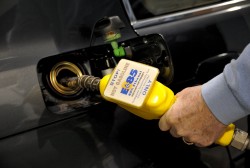Flex-Fuel Vehicles: Is Fueling With E85 Worth It?

By Paul Crosby, TestDriveNow.com
There is a great discussion going on in our country concerning ways to reduce our dependence on foreign oil. Electric and hybrid vehicles have proved a popular alternative to traditional internal combustion motors. However, most drivers still opt for standard autos with gasoline or diesel power plants. One very interesting alternative that has been brought to market over the past decade is the ethanol-fuel blend of E85. This type of fuel is a combination of up to 85% denatured ethanol mixed with gasoline by volume.
Benefits: E85 fuel has a number of benefits compared to traditional petroleum products. Reduced tailpipe emissions, higher octane rating for more power, and lower combustion temperatures for less wear and tear on the engine internal components are just a few of the benefits of this fuel type. Another major benefit of E85 is that it can be produced closer to the end user; greatly reducing the transportation and production costs compared to gasoline, and therefore the price you pay at the pump.
Barriers: Though E85 is promising and appears to have numerous benefits compared to gasoline, the performance of the fuel so far is not as promising. Many industry experts feel that the problem is not so much the E85 fuel, but that the automakers have not developed the flex-fuel vehicles well enough to take advantage of the full potential of E85. On average, E85 fuel has about two thirds of the energy content of traditional unleaded gasoline. Quite simply, you would need about 33% more E85 by volume to accomplish the same amount of work as gasoline. This difference would be acceptable if E85 where half the price of gasoline, but it’s not. On average, E85 is currently 90-95% of the price of traditional fuels. The ethanol component of E85 comes primarily from corn, so the price of the finished fuel is dependent on the wild swings in the price of corn. There are several companies currently working on different types of plants that are easily grown and yield a higher ethanol content per acre than corn, thereby creating a new and hopefully more cost efficient source of fuel.
A Better Engine Is Needed: To truly take advantage of the many promising characteristics of this fuel, automakers need to develop new engines that are made for the unique characteristics of E85. So far, most of the flex-fuel designs are simply gas-powered engines modified to accept the E85. This results in less than perfect solutions; the motors get worse mileage on E85, and they tend to get worse mileage on traditional fuels compared to similar gasoline only motors. This technology is in its infant stage – we are not quite there yet but E85 could prove to be a very strong alternative to gasoline as a source of power in the autos of tomorrow.

